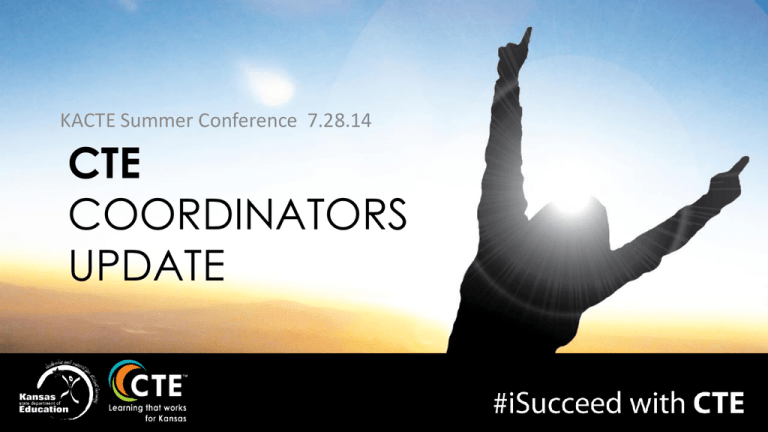KACTE CTE Coordinators Update - Kansas State Department of
advertisement

KACTE Summer Conference 7.28.14 CTE COORDINATORS UPDATE KSDE CTE Team Purpose Support and empower schools in developing quality pathways that lead students to college and career readiness Here’s what we’re facing… Kansans with “Some Post-secondary” 52% Some Post-secondary = Credential through Advanced degree Kansas Class of 2012 • Percentage of 2012 Graduates enrolled in Post-secondary (2 & 4 yr. institutions) 76% • Percentage of 2012 Graduates completing 1 year of postsecondary 49% System for Education Enterprise in Kansas (SEEK) Authenticated Application containing building-level data related to student performance in postsecondary KSDE - Authenticated Applications College and Career Ready in Kansas College and Career Ready means an individual has the academic preparation, cognitive preparation, technical skills, and employability skills to be successful in postsecondary education, in the attainment of an industry recognized certification or in the workforce, without the need for remediation. IPS Webpage Individual Plans of Study What is an IPS? • Product - Multi-year educational plan based on career interests • Process – Providing students access to career development It’s NOT just a graduation plan What are the obstacles in moving students toward quadrant D, high rigor and high application? 1. Living in the Past – Always done that way 2. Scheduling 3. Licensure 4. Carnegie Units 5. Finances 6. Different levels of High Rigor per student 7. Lack of support to provide PD to teachers for the changes 8. Limited opportunities for work-based learning in community What do we need to start doing to move students into Quadrant D? 1. Cause students to think critically 2. Integration/Team Teaching 3. Differentiated Teaching Strategies 4. Increased Relevance What do we need to stop doing to move students into Quadrant D? 1. Less Standards – Higher/Fewer/Clearer (Common Career Technical Core) 2. No Competency Profiles Which one of the following seven areas in CTE do you feel you need the most support and guidance from KSDE during 2014-2015? • Integration • Career Awareness and Guidance • Partnerships • Support and Recognition • Innovation • Strategic Planning • Instructional Practice 2014 CTE Drive-Ins • September 3rd – Civic Center, Dodge City • September 4th – NW KS Service Center, Oakley • September 17th – Webster Conference Center, Salina • September 22nd – Greenbush Service Center, Girard • October 1st – Johnson County Community College, Overland Park Register here for 2014 CTE Drive-Ins Approved Pathways by Cluster 2013-14 • Agriculture – 361 • Architecture & Construction – 301 • Arts, AV, Comm. – 241 • Business Management – 94 • Education & Training – 65 • Finance – 179 • Govt. & Public Admin. – 10 • • • • • • • • • Health Science - 62 Hospitality & Tourism – 97 Human Services - 333 Information Tech. – 208 Law, Public Safety – 15 Manufacturing – 102 Marketing - 88 STEM – 92 Transportation – 50 Total - 2298 - (+99 from 2012-13) Approved Pathways by Cluster 2014-15 Agriculture 356 Govt. & Public Admin 11 Marketing Health Science 62 STEM Architecture & Construction 299 Hospitality & Tourism 108 Transportation Arts, AV, Comm. 267 Human Services 348 Total Business Ent. & Management 102 Information Tech. 214 Law, Public Safety 25 Education & Training Business Finance 79 181 Manufacturing 105 91 135 49 2471 (+176 from 2013-14) Success of Senate Bill 155 HS Headcount College Credit Hours # Credentials (Public & Private) $ Incentives for Credentials # Districts Participating 2011 2012 2013 2014 3,475 3,870 6,101 8,208 28,000 28,161 44,087 60,799 711 1419 $ 694,167.50 $ 1,419,000 108 160 • In 2014, College CTE courses taken by HS students - a 112% increase in headcount and 116% increase in college credit hours over the baseline year 2012) • 1,419 secondary students earned industry-recognized credentials leading to a high demand occupation - an increase of 159% over the 548 credentials earned the baseline year (2012) • Major areas for secondary student certifications: 73% Health; 9% Construction; 7% Manufacturing; 6% Automotive; 4% Agriculture Senate Bill 155 Funding 25,719,784 25,000,000 20,000,000 15,000,000 10,000,000 5,000,000 0 11,750,000 16,969,784 3,000,000 8,750,000 8,750,000 FY 2013 FY 2014 Supplemental Appropriation Statewide Articulation Agreements • Currently have statewide agreements with 12 post-secondary institutions • 77 total statewide agreements • 29 Pathways have statewide agreements Additions to the Pathway Changes Fact Sheet for 15-16 Changes to Pathways for 15-16 School Year Old Code Title New Code 22250 Career & Community Connections 45250 12108 Advanced Accounting 33108 12168 Marketing Communication 35168 18506 Environmental Resources & Wildlife Science 37506 21111 GIS Technology 21058 15-16 Pathway Application Updates In Progress 1. New Pathway Improvement Plan format 2. No advisory committee meeting minutes (keep on file locally) 3. District-level Pathway application option 4. “Change”, “No Change” button on each section except for Section 2b to inform consultant 5. 8th grade intro. course credit will count towards 3.0 credit minimum requirement for pathway 6. Drop down menu of certifications in addition to the open text box will provide more options 7. Email address for advisory committee members will not be required Career Pathways Assessments System (cPass) • cPass General CTE– summative college/career ready assessment (academic, 21st century skills, leadership, employability) Specific End-of-Pathway assessments – technical skill assessments New Licensure Regulations Summary of HB 2506 • STEM – degree in STEM-related field (finance and accounting as well) + 5 years of related work experience + offer from a school district • CTE – IRC + 5 years related work experience OR - IF less than 0.5 teaching position, verified occupational competency (exam, license, IRC, 4000 hrs. work experience) Lead Consultant Last Year Reviewed Year to begin Review Kurt Dillon 2012-2013 2012-2013 Architecture & Construction Peggy Torrens 2008-2009 2013-2014 Arts A/V Technology & Communications Gayla Randel 2010-2011 2016-2017 Business Management & Administration Kirk Haskins 2009-2010 2015-2016 Gayla Randel 2007-2008 2013-2014 Finance Kirk Haskins 2008-2009 2013-2014 Government & Public Administration Don Gifford 2010-2011 2015-2016 Health Science Wenda Pickell 2007-2008 2013-2014 Hospitality & Tourism Gayla Randel 2009-2010 2015-2016 Human Services Gayla Randel 2008-2009 2014-2015 RJ Dake 2008-2009 2014-2015 Law, Public Safety, Corrections & Security Peggy Torrens 2010-2011 2016-2017 Manufacturing Peggy Torrens 2009-2010 2014-2015 Marketing Kirk Haskins 2008-2009 2014-2015 STEM Melissa Fast 2009-2010 2015-2016 Cluster Agriculture Food & Natural Resources Education & Training Information Technology Pathway Assessment Rubric Developed in response to requests from schools for guidance with: 1. Creating meaningful improvement plans 2. Engaging advisory committee members Pathway Assessment Rubric • Voluntary • Will not be shared with KSDE • BEST PRACTICE – Teacher(s) of a Pathway complete the assessment along with Advisory Committee • Contains four components of a quality Pathway (all four are part of a draft of the CTE Accreditation Model) • Partnerships • Physical Environment • Instructional Practices • Professional Development Component Indicator IV. Instructional Strategies A. Instruction is balanced between classroom & laboratory instruction, experiential learning, and leadership & personal development Missing or non-existent. Needs Improvement—One component of the classroom and laboratory instruction, experiential learning, and leadership and personal development dominate the curriculum, while others are minimally addressed or ignored. Improving—While one component of the curriculum is clearly Stages dominating the instruction, there is a plan for bringing the deficient area(s) into balance with input from the advisory committee and state staff. Promising-Evidence exists that an attempt is made to balance the curriculum across all components utilizing input from the local advisory committee. Exemplary—A well-planned balance exists among all curriculum components. The balance is documented and is a result of collaboration with all stakeholders and state requirements. “Score” a Pathway • Think of one Pathway • Assess the Pathway in only ONE component • Under each indicator, check boxes next to the stage that best fits the current status of the Pathway Reflection Questions Which indicators did you score at the struggling or missing (non-existent) stage? (These are considered critical areas your pathway improvement plan should address.) 3 yr. Pathway Improvement Plan Template • Use the results from the Pathway assessment rubric to develop SMART (specific, measurable, attainable, realistic, timely) goals for each component • Very similar to the new template of the Pathway Improvement Plan in the Pathway application • If you feel the Pathway assessment rubric would be a valuable tool, please use it during your fall Advisory Committee Meeting • More time and training will take place during the Fall CTE Drive-In Workshops HAVE A FANTASTIC START TO THE SCHOOL YEAR!








